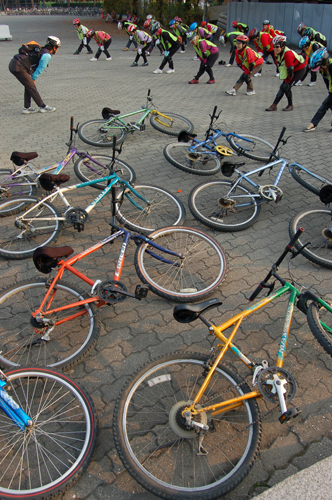
|
Bike BoomKoreAm Journal/May 2010
Frustrated with traffic and gas prices, more seoulits are making bicycles their transportation of choice
Most mornings, Lee Kwang-Ja hops on her bike and negotiates Seoul's clogged streets and highly aggressive motorists to get to her job. When she reaches the Han River, she's got it made—bike-only lanes all the way into the Songpa neighborhood. The commute takes only about 30 minutes. By car, it would take her 90, mostly because of traffic. "Bike commuting gives me a pleasant mind and a healthy body," said Lee, 59, who has been riding her bike to work for the past six years. She is one of a still fairly small number of Seoulites who commute by bicyele, but the trend is starting to gets it legs, thanks in part to multiple concerns about traffic congestion, air quality, health, gas prices and parking shortages. In the last few years, Seoulites have pressed for more bikes-only paths, and the city is responding. Seoul Mayor Oh Se-hoon wants 10 percent of city residents using bikes as their main mode of transportation by 2020. And to make that possible, the city is building 300 kilometers (186 miles) of new bike lanes by 2014. Cycling commuters like Lee have been anxiosly awaiting such changes. She is women's organization director of PABLE, which stands for the Promotion Association of Bicycling for a New Life Environment, a nonprofit helping the city realize this bike-friendly dream. The organization, with offices located inside Songpa's Olympic Park, has 3,000 active members and teaches them how to bike safely. The group also educates the public about biking as a way to improve the environment, especially in a city like Seoul with its poor air quality. Sixteen year old PABLE has trained 12,000 bikers. Most members bike for recreation, to run errands and for other short-distance trips. Some of the younger members bike to work. "The bike boom is almost explosive here in Seoul," said Lee, crediting SeoulŐs mayor, a bike enthusiast, for promoting the cycling lifestyle. "The last two or three years, more people are riding bikes for commuting and shopping. Many people understand it's expensive to use a car. So many [more] will join the boom once there are more and safer bike trails." She cited the biggest challenge is getting motorists to respect the space of bikers. "They still think the bike is a hindrance on the road," Lee said. A number of PABLE members have been injured in bike accidents. But the accidents, which occurred every three-four years, were considered unusual because PABLE members are trained to ride bikes slowly and safely. Later, outside Lee's office, an afternoon PABLE class rolls in. Two dozen women in multi-colored biker shirts and helmets circle the open area. They end the lesson with stretching exercises. Moon Yo-hwan, 69, said biking has become her life in the last 13 years. She uses it for shopping and visiting friends. The widow even moved to Songpa because itŐs known to be a bike-friendly area. "Riding a bike restored my health," she says. Even injuries, such as a dislocated arm, have not detracted her. "As a beginner I was afraid," admitted another Songpa resident, Na Keum Bong, who now rides her bike daily. "Now I can protect myself. The bike is more convenient than waiting for the bus. You can just go." * * * * *
A bike-friendly Seoul isn't a dream, it's a plan, says Lee Hae Kyeong (no relation to Lee Kwang-ja) of the Seoul Metropolitan Government's Bicycle Traffic Division, with offices located in City Hall. The division works on designing Seoul's new bike commuting routes and, already in 2010, it has budgeted 29 billion won ($24 million) to build new bike-only lanes on major roads as well as to improve existing lanes, she said. Seoul's mayor is trying to make it possible for anyone to bike commute, she said. A triathlete himself, Mayor Oh feels that if bike riding becomes commonplace, traffic will decrease and development can take on a greener quality. Lee Hae Kyeong unfurled a large map and pointed out Seoul's first bike-only paths built along the Han River in the early 1980s, making it possible to bike commute from Jamsil to Yeouido. Then she pointed out where new bikes-only lanes are planned. One continuous such lane will travel through downtown by 2012. Another two will encircle downtown by 2014. The so-called "road diet" plan will call for the narrowing of car lane widths and reducing the number of car lanes to make space for the bike lanes. In addition, bike parking spaces are being installed at subway stations. "We're also creating 12 bike-friendly neighborhoods by 2012, and 33 by 2020," Lee added. "In these neighborhoods, existing bike lanes will be improved and connected for short distance trips to work, schools, and stores." As promising as these plans are, bike-riding promoters acknowledged that SeoulŐs citizens may have a difficult time embracing a bike-friendly culture at first. Lee Hae Kyeong said that some have already been complaining about plans to reduce car lanes. But she remained optimistic. "Once people get educated and once biking is made easier, safer, and more convenient, people will like the idea--and do it." People like Hong Seok-ki, an insurance company advisor, who was biking along the Han River bike trail near Bampo Bridge, on his way to work. Hong, who's in his thirties, said he just started bike riding to work a week ago. He changes out of his biking clothes at work, where he keeps a suit. "After I got married, I gained weight," explained Hong Hang, sweating profusely after riding from the direction of Yeouido towards Jamsil. "So I'm trying this. Riding my bike to work is healthy." And probably good for his marriage, too. |
||
|
|
||








